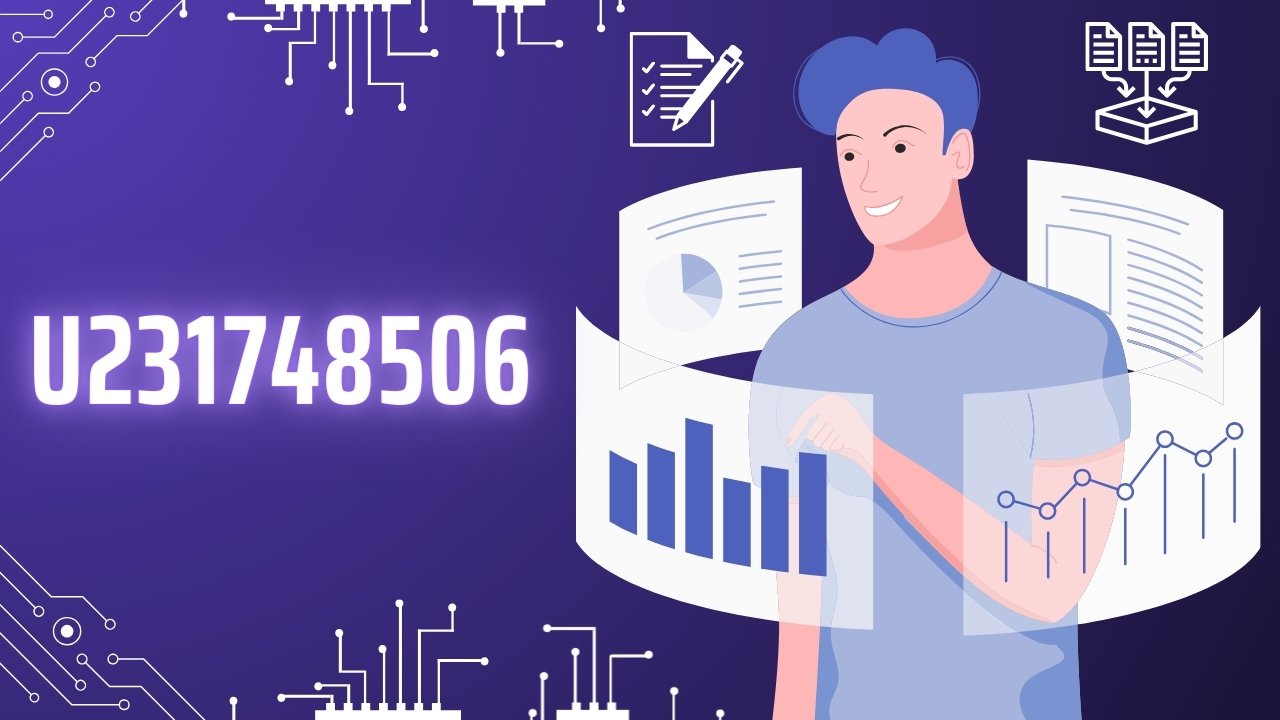In the vast landscape of data analysis, certain codes and sequences hold the key to unlocking critical insights. One such sequence is U231748506. This alphanumeric code has emerged as a cornerstone in the realm of data science, offering a structured and reliable framework for data categorization and interpretation. But what exactly is U231748506, and why is it so crucial for data analysts and tech enthusiasts?
U231748506 is an exemplary model of how intricate sequences can streamline complex data processes. By encapsulating vast amounts of information in a single, coherent format, it enables analysts to efficiently handle and interpret data, ultimately driving more informed decision-making processes. This blog post will delve deep into the origins, applications, and future prospects of U231748506, shedding light on its significance in the ever-evolving field of data analysis.
Historical Background
The Genesis of U231748506
The journey of U231748506 began in the early 2000s when the need for more sophisticated data handling systems became apparent. As industries rapidly digitized, the volume of data generated grew exponentially. Traditional methods of data categorization and storage were becoming obsolete, necessitating the development of more advanced coding systems.
Researchers and data scientists collaborated to create a system that could handle large datasets with ease and precision. Thus, U231748506 was born. Its alphanumeric structure was designed to be both human-readable and machine-processable, making it a versatile tool in the data analyst’s toolkit.
Evolution Over the Years
Since its inception, U231748506 has undergone several iterations and improvements. Initially, it was primarily used in academic and research settings. However, as its utility became more evident, industries began to adopt it for various applications, ranging from financial analysis to healthcare data management.
The flexibility and robustness of U231748506 allowed it to adapt to different data environments, ensuring its relevance even as technological landscapes evolved. Today, it stands as a testament to the power of collaborative innovation in the field of data science.
Practical Applications
Data Categorization and Storage
One of the primary applications of U231748506 is in the categorization and storage of data. Its structured format allows for efficient indexing and retrieval, making it easier for analysts to access relevant information quickly. This is particularly useful in industries that handle vast amounts of data, such as finance and healthcare.
For example, in the financial sector, U231748506 can be used to categorize transaction data, enabling analysts to identify trends and anomalies with ease. In healthcare, it can help in organizing patient records, ensuring that critical information is readily accessible for medical professionals.
Enhancing Data Security
Data security is a major concern in today’s digital age, and U231748506 plays a crucial role in enhancing it. The alphanumeric structure can be encrypted, adding an additional layer of protection against unauthorized access. This is especially important in industries that handle sensitive information, such as banking and government.
By using U231748506, organizations can ensure that their data is not only well-organized but also secure, protecting it from potential breaches and cyber-attacks.
Facilitating Data Analysis
Data analysis often involves sifting through large datasets to identify patterns and insights. U231748506 simplifies this process by providing a standardized format for data storage. This makes it easier for analysts to apply various analytical tools and techniques, ultimately speeding up the analysis process.
For instance, in marketing, U231748506 can be used to categorize customer data, allowing analysts to segment audiences and tailor marketing strategies accordingly. This can lead to more targeted campaigns and higher conversion rates.
Improving Data Interoperability
In a world where data is often shared across different platforms and systems, interoperability is key. U231748506 enhances data interoperability by providing a common language that different systems can understand. This ensures that data can be easily transferred and integrated, facilitating smoother collaboration and information sharing.
For example, in the supply chain industry, U231748506 can be used to standardize data across different stakeholders, ensuring that everyone is on the same page. This can lead to more efficient operations and better decision-making.
Future Prospects
Advancements in AI and Machine Learning
As artificial intelligence (AI) and machine learning (ML) continue to evolve, the role of U231748506 in these fields is expected to grow. The structured format of U231748506 makes it an ideal candidate for training AI and ML models, enabling them to learn from large datasets with greater accuracy and efficiency.
In the future, we can expect to see more sophisticated AI and ML applications that leverage U231748506 for tasks such as predictive analytics, natural language processing, and image recognition. This will open up new possibilities and drive further innovation in the field of data science.
Expanding Industry Applications
While U231748506 is already widely used in various industries, its potential applications are far from exhausted. As new industries emerge and existing ones continue to digitize, the need for efficient data management systems will only increase. U231748506 is well-positioned to meet this demand, offering a reliable and versatile solution for data categorization and analysis.
For example, in the burgeoning field of smart cities, U231748506 could be used to manage and analyze data from various sources, such as traffic sensors, energy grids, and public services. This could lead to more efficient urban planning and improved quality of life for residents.
Enhancing Data Ethics and Governance
As data becomes increasingly central to decision-making processes, the importance of data ethics and governance cannot be overstated. U231748506 can play a crucial role in ensuring that data is handled responsibly and transparently. Its structured format allows for better tracking and auditing of data, ensuring that it is used ethically and in compliance with regulations.
In the future, we can expect to see more robust frameworks for data governance that leverage U231748506 to promote transparency, accountability, and trust in data practices.
You May Also Like: Wadware’s Evolution: A New Era of Tech Excellence
Conclusion
U231748506 represents a significant advancement in the field of data analysis, offering a structured and reliable framework for data categorization and interpretation. Its journey from a simple alphanumeric code to a cornerstone of modern data science is a testament to the power of innovation and collaboration.
As we look to the future, the potential applications of U231748506 are vast and varied. From enhancing AI and ML capabilities to improving data interoperability and security, this alphanumeric code is poised to play a central role in the continued evolution of data science.
For data analysts and tech enthusiasts, understanding and leveraging U231748506 is not just an option—it’s a necessity. As we navigate the complexities of the digital age, the ability to efficiently manage and analyze data will be a key determinant of success.
We invite you to join us in exploring the potential of U231748506. Whether you’re a seasoned data analyst or a tech enthusiast just starting your journey, there’s always something new to learn and discover. Together, we can unlock the full potential of this remarkable tool and drive innovation in the world of data science.
Interested in diving deeper into the world of U231748506? Sign up for our newsletter to stay updated on the latest developments and insights. Let’s transform data into actionable intelligence and shape the future of data analysis together!
Frequently Asked Questions
What is U231748506, and how is it used in data management?
U231748506 is a standardized alphanumeric code designed to improve data categorization and organization. It plays a crucial role in enhancing data security, facilitating data analysis, and improving interoperability across different platforms and systems. Its structured format makes it easy to encrypt and protects sensitive information from unauthorized access.
How does U231748506 enhance data security?
The structure of U231748506 allows for data to be encrypted effectively, adding an extra layer of protection. This is particularly valuable in industries that handle sensitive information, such as banking and government, ensuring that data is well-organized and protected against potential breaches and cyber-attacks.
Can U231748506 be used in AI and machine learning applications?
Yes, U231748506 is highly suitable for use in AI and machine learning applications. Its structured format makes it an ideal candidate for training models on large datasets, enabling more accurate and efficient learning. It can be used for tasks like predictive analytics, natural language processing, and image recognition, thereby driving innovation in data science.
What industries can benefit from using U231748506?
While U231748506 is already used in a variety of industries, its potential applications continue to expand. Industries such as marketing, supply chain management, smart cities, and more can benefit from its ability to standardize and analyze data efficiently. This leads to improved decision-making, targeted marketing strategies, and streamlined operations.
How does U231748506 contribute to data ethics and governance?
U231748506 plays a significant role in promoting data ethics and governance by providing a structured format that facilitates better tracking and auditing. This ensures that data is handled responsibly and transparently, in compliance with regulations. As data governance frameworks evolve, U231748506 will continue to support transparency, accountability, and trust in data practices.











